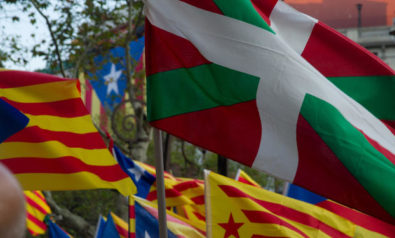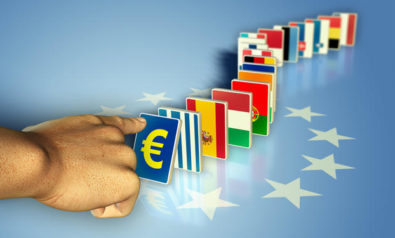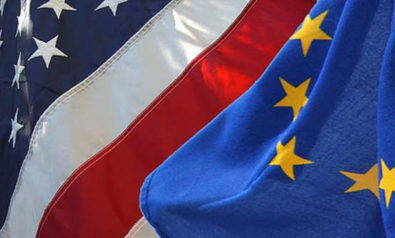Camille Barré looks back at the theories that shaped debate on EU integration and asks what the European Union might do to counter the wave of internal separatism.
The EU has been trying to find new solutions to improve the union and to make it stronger. One proposal in particular has sparked interest as well as scepticism: to transform the European Union into a federation of nation states. José Manuel Barroso, the president of the European Commission, is the one who introduced the idea of a “United States of Europe” in his speech on the “State of the Union” made to the European Parliament in September 2012. "Let's not be afraid of the words: we will need to move towards a federation of nation states. This is what we need. This is our political horizon. This is what must guide our work in the years to come."
This idea created a lot of commotion, as it can be perceived as a threat to national democracies if the EU were to become a “super state” similar to the United States of America. However, Barroso did stress the fact that in no way should national governments fear this idea, for he envisions the federation of member states as a “democratic federation of nation states that can tackle our common problems, through the sharing of sovereignty in a way that each country and each citizen are better equipped to control their own destiny”.
Evolution of Integration Theories
The evolution of European integration theories begins with the early strategies put forward between 1920s-50s that included federalism and functionalism – theories that explained that the European Union is identified by how its member states act together rather than what they are made of individually. These theories were put forward in order to stop nationalism and, most importantly, end the war. Afterwards, between 1950s-1970s came neo-functionalism, which can be seen as the core theory of European integration, best explained by US scholar Haas as“the process whereby political actors in several distinct national setting are persuaded to shift their loyalties, expectations and political activities towards a new and larger centre, whose institutions demand jurisdiction over the pre-exiting national states”.
This was followed by intergovernmentalism in the 1980s and 1990s and would counter most of the aspects of neo-functionalism by stating that national interest was still much stronger than the European interest and that integration had overlooked aspects such as security and defense that were still more of a national decision. Both aspects were put to the test when Europe found itself in the middle of the Cold War and the EU needed to stand united on those issues more than ever.Intergovernmentalism emphasizes the role of the nation state in integration, and suggests that the nation state will not become obsolete due to European integration. This theory was later developed intoliberal intergovermentalism, a theory explaining that member states of the European Union had failed to surrender their sovereignty completely. In order to improve this it explained that member states must surrender their bargaining power in order to achieve full integration.
Last, but not least, came the institutionalism theory, which opened a possibility of finding a true definition of integration by looking at other disciplines such as constructivism – a theory based on the fact that knowledge and ideas can create European identities through social interaction. It focuses on the shared understanding of norms and behaviors that member states have between each other, instead of having member states pivot their own social identities and put forward their preferences. Also, it favours strong institutions that work with nations as well as for them, such as the European Commission that develops ideas to improve the EU, and the European Parliament – an institution created to give the people of Europe a voice.
Which Federalism?
Now, when speaking of possible ways towards integration, we come across two kinds of federalism. One is integrative federalism, which is created through consent of different units, the other is a devolutive federalism, which is created from division of units into political autonomous sub-units. These two kinds of federalism mentioned by Walter van Gerven are what can explain the connection between the United States of America and the European Union when it comes to federalism, and it also introduces how they differ from one another. Simply put, both parties are influenced by federalism. The concept of federalism associated with the United States of America can be simply explained as a type of government where power is split between a national government and other smaller governmental cores. The US has an integrative federal structure because the government was created in order to unify the 13 colonies into a strong block against foreign powers. Therefore, they ceded their power through consent to create a strong central government while also retaining the independence of each state, in order to insure their survival at the time. On the other hand, the EU was also created as a form of central power, but its members did not cede any decision-making powers, but rather delegated to this central authority.
One must not forget that in fact, at the end of World War II, it was Winston Churchill who first brought up the idea of a United States of Europe in his 1946 speech in Zurich when he said: "We must build a kind of United States of Europe. In this way only will hundreds of millions of toilers be able to regain the simple joys and hopes which make life worth living." It was with those thoughts that the European Union became what it is today.
Yet today the idea of a United State of Europe is perceived more negatively then in 1946. The prospect can in fact be scary as it could lead to the loss of national power to a pan-European body, which is not clearly understood. Barroso strictly affirmed that he was not searching for a full federal union but a union that would have a stronger central power system of sharing sovereignty and empowering Europe’s people. As it is through this sharing of sovereignty that member states and its citizens will be better equipped in shaping their European destiny. It will first start with the Commission putting forwards all of the necessary changes in order for Europe’s citizens to have a stronger voice within the EU. The commission is to present these changes before the European Parliament election in 2014. This is why the importance of the European Parliament is crucial. Only through its 2014 elections will these changes take place.
For or Against?
Opinions on this issue are mixed. France and Germany seem to be more accepting of this idea. Furthermore, general polls have shown that between 1995 and 2010 people in Europe were favorable to the development of such changes. The reason for the support from the French public is due to the appreciation that the people of Europe would have a stronger voice on the functioning of the Union. Politicians like Angela Merkel support the idea because they want to set a fiscal union policy within the euro zone as well as a stronger European Court of Justice that could sanction governments that behave irresponsibly. The Italian Prime Minister Mario Monti also seems in favor, as he views countries as responsible for the fiscal and debt crisis and perhaps a new path is necessary to fix the damage done, the new path being a more equal cooperation between member states.
However, negative opinions towards this idea tend to come mainly from the United Kingdom. Newspapers mock the idea of a united Europe, stating, “The motto of the United States of America is “E pluribus unum”(Out of many, one). The European Union's motto is "In varietate concordia", which is officially translated as "United in diversity". It is difficult to express the differences between the US and the European model any more clearly than this. The US is a melting pot, whereas Europe is amosaic of different peoples and cultures that has developed over the course of its long history.” In short, the EU could never follow in the United States footsteps.
The president of the European Central Bank, Mario Draghi, is also reluctant to see the benefits, especially with regards to the economical aspects of the union. He would much rather prefer that this political integration develop in parallel with economic integration. Finally, the Dutch media have introduced the idea of a separation of the northern countries from the southern ones in order for the EU to survive, starting by splitting the euro zone into northern and southern parts.
The notion of a federation of nation states is what has been put forward in an attempt to rescue the European Union. Apart from some similitude with the United States with regards to allowing for a stronger and more centralised authority, the coining of this expression falls short. As we have seen, the federalism that filled the evolution of the United States has nothing to do with the federalism that shaped the EU after the war or the federalism mentioned in Barosso’s speech. History shows that different integration theories fueled the EU’s path unsuccessfully until now. Beginning with federalism, the debate on integration was overtaken by theories demonstrating how member states refused to let go of their national interest in order to help the EU move forward as a central power. In today’s Europe these theories can no longer be applicable, and the solution given is to come back to Churchill’s idea of federalism. The question today is, Are we in a place where countries would allow such changes and let go of their hold of EU decisions? This has clearly stalled EU integration or, worse, imposed unconstitutional decisions to its members in difficulty like Greece. The idea of a United States of Europe is still merely an idea, and only through the real commitment of the member states over time will it be possible to evaluate the possibility of its implementation.
The views expressed in this article are the author's own and do not necessarily reflect Fair Observer’s editorial policy.
Image: Copyright © Shutterstock. All Rights Reserved.
Support Fair Observer
We rely on your support for our independence, diversity and quality.
For more than 10 years, Fair Observer has been free, fair and independent. No billionaire owns us, no advertisers control us. We are a reader-supported nonprofit. Unlike many other publications, we keep our content free for readers regardless of where they live or whether they can afford to pay. We have no paywalls and no ads.
In the post-truth era of fake news, echo chambers and filter bubbles, we publish a plurality of perspectives from around the world. Anyone can publish with us, but everyone goes through a rigorous editorial process. So, you get fact-checked, well-reasoned content instead of noise.
We publish 2,500+ voices from 90+ countries. We also conduct education and training programs
on subjects ranging from digital media and journalism to writing and critical thinking. This
doesn’t come cheap. Servers, editors, trainers and web developers cost
money.
Please consider supporting us on a regular basis as a recurring donor or a
sustaining member.
Will you support FO’s journalism?
We rely on your support for our independence, diversity and quality.













Comment
More than 36 states of the US want to seceed and they know why. And more and more states in the EU want to seceed they know why too.
Because iron and clay don’t fit together and peoples bound together by political or economicla pressure will NEVER EVER BE FREE.
FREEDOM is the root to love and empathy, pressure always will lead to war and destruction.
“Give peace a chance”